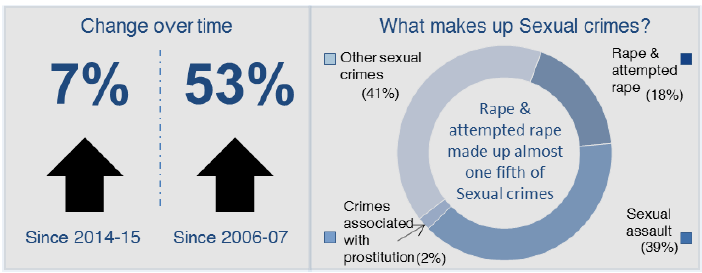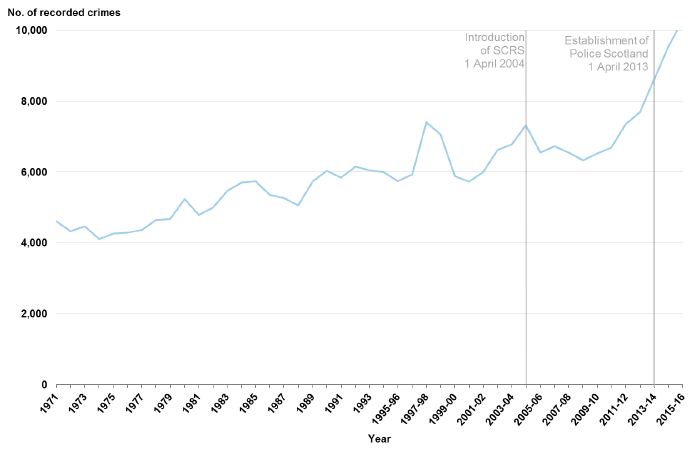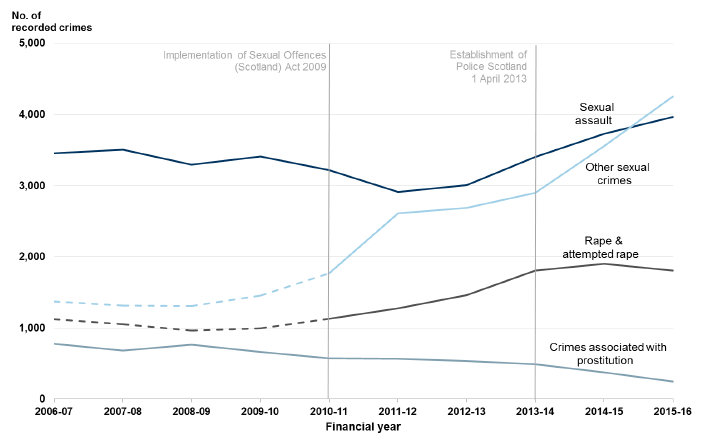Recorded Crime in Scotland, 2015-16
Statistics on crimes and offences recorded and cleared up by the police in Scotland.
This document is part of a collection
Group 2 - Sexual Crimes

Number of Sexual crimes recorded in 2015-16:
Sexual crimes account for 4% of all crimes recorded in Scotland in 2015-16. The number of Sexual crimes recorded by the police in Scotland increased by 7% from 9,557 in 2014-15 to 10,273 in 2015-16.
Chart 8 below shows the number of Sexual crimes from 1971 onwards. Sexual crimes have been on a long-term upward trend since 1974, and have increased each consecutive year since 2008-09. Sexual crimes are at the highest level seen since 1971, the first year for which comparable crime groups are available.
Chart 8: Sexual crimes recorded by the police, 1971 1 to 1994 then 1995‑96 to 2015-16 ( Table 10 )

1. Crimes recorded for the present crime groups are not available prior to 1971.
The national rate of recorded Sexual crimes increased from 18 crimes per 10,000 population in 2014-15 to 19 crimes per 10,000 population in 2015-16. This varied by local authority area, with the highest rates in Dundee City and Glasgow City (both 28 per 10,000 population), and the lowest in East Dunbartonshire (7 per 10,000 population) ( Table 13).
Whilst the specific age of the victim cannot generally be determined from the data supplied by Police Scotland, many of the sexual crime codes used by the Police to record crime make it clear when the victim was aged under 18 (for example, Sexual assault of older male child (13-15 years)) [6] . By adding up all these crime codes, we know that at least 43% of the 10,273 sexual crimes recorded in 2015-16 by the police related to a victim under the age of 18. This proportion is unchanged on the previous year.
Chart 9: Sexual crimes in Scotland, 2006-07 to 2015-16

Chart 9 shows the four categories within Sexual crimes over the last ten years, and gives an indication of the trend and scale of each category. The proportions of the Sexual assault and Other sexual crimes categories have changed markedly over time, almost converging after 2010, which coincides with the implementation of the Sexual Offences (Scotland) Act 2009. In 2015-16, the number of Other sexual crimes has exceeded that of Sexual assault for the first time since 1990. Information on the impact of Sexual Offences (Scotland) Act 2009 is available under Data Considerations below. The proportion of Rape and attempted rape has remained fairly constant over time, whereas that of Crimes associated with prostitution has fallen considerably.
Table A1 contains more detailed breakdowns for Sexual crimes.
Sexual assault:
Sexual assault accounted for 39% of Sexual crimes in 2015-16. This category has been on an upward trend since 2011-12, having increased by 36% since that time. This includes a 6% increase from 3,727 in 2014-15 to 3,963 in 2015-16.
Just over half (18) of local authorities recorded an increase in sexual assault since 2006-07 and exactly half (16) recorded an increase between 2014-15 and 2015-16. Highland increased by 56% from 135 crimes in 2014-15 to 211 in 2015-16. While this local authority accounted for only 5% of the crimes in this category, this increase is the equivalent of almost one third (32%) of the overall change in Sexual assault and 11% of the overall change in Sexual crimes as a whole.
One of the main drivers behind the increase in Sexual assault between 2014-15 and 2015-16 was a 56% increase in crimes of Sexual assault by penetration of a female (16+), accounting for more than one third (35%) of the overall increase, but only 6% of the total crimes recorded within this category.
Rape & attempted rape:
It should be noted that due to the implementation of the Sexual Offences (Scotland) Act 2009, comparisons with data prior to 2010-11 should be treated with caution. Additional information relating to the implementation of this legislation is available in the 'Data Considerations' section below.
Rape & attempted rape accounted for 18% of Sexual crimes. These crimes decreased by 5% from 1,901 in 2014-15 to 1,809 in 2015-16. This follows a previous upward trend since 2010-11, with Rape & attempted rape increasing by 60% overall between 2010-11 and 2015-16. All local authority areas recorded an increase in this category during this time, except for the Shetland Islands and West Lothian.
Crimes associated with prostitution:
Crimes associated with prostitution account for less than 2% of Sexual crimes. Over the ten year period from 2006-07 to 2015-16, these crimes have seen a large fall of 68%, including a 34% decrease from 374 in 2014-15 to 247 in 2015-16.
Almost all crimes within this category (97%) are recorded in the city based local authority areas covering Edinburgh, Glasgow, Aberdeen and Dundee. All four of these recorded a decrease over the ten year period. This trend continued between 2014-15 and 2015-16, with the exception of Aberdeen City which saw an increase of 55% from 49 in 2014-15 to 76 in 2015-16. At the same time Dundee City saw crimes associated with prostitution fall from 34 to 1.
Other sexual crimes:
The Other sexual crimes category includes crimes such as Other sexually coercive conduct, Other sexual crimes involving 13-15 year old children, Taking, distribution, possession etc. of indecent photos of children, Incest, Illegal homosexual acts, Indecent exposure and Other sexual crimes.
As with Rape & attempted rape, it should be noted that due to the implementation of the Sexual Offences (Scotland) Act 2009, comparisons with data prior to 2010-11 should be treated with caution. Additional information relating to the implementation of this legislation is available in the 'Data Considerations' section below.
Other sexual crimes are now the largest category in Group 2, accounting for 41% of Sexual crimes. This category has been on an upward trend since 2010-11, having increased by 140% within that time, including a 20% increase from 3,555 in 2014-15 to 4,254 in 2015-16. All local authority areas recorded an increase in this category over the five year period from 2010-11 to 2015-16.
DATA CONSIDERATIONS
Sexual Offences (Scotland) Act 2009
The implementation of the Sexual Offences (Scotland) Act 2009 on 1 December 2010 resulted in a redistribution of Group 2 crimes among the subcategories. Comparisons over time of the breakdown of Sexual crimes should therefore be treated with caution. However, no new crimes were introduced as a result of the legislation and consequently we do not consider there to be a break in the time series.
The Sexual Offences (Scotland) Act 2009 widened the definition of Rape and therefore comparisons of the category Rape & attempted rape with data prior to 2010-11 should be treated with caution.
There are a number of crimes such as Indecent communication and Voyeurism which may have been recorded as Breach of the peace prior to the implementation of the Act, and which therefore would not have shown up as sexual crimes before December 2010. This coincides with the increase in Other sexual crimes in 2011-12. Therefore, comparisons of the category Other sexual crimes with data prior to 2010-11 should be treated with caution.
In 2010-11, incidents of Taking, distribution etc. indecent photos of children were transferred from Group 6 Miscellaneous offences to Group 2 Sexual crimes. At the time, figures were back-revised to 2009-10. As these incidents accounted for 6% of all Group 2 Sexual crimes in 2015-16, it should be noted that, although figures for this crime have increased over time, a small discontinuity is present in the time series for any analysis that spans 2009-10.
Historic reporting
Table A1 reports 1,071 crimes of Lewd and Libidinous practices in 2015-16. These crimes should all relate to offences which occurred prior to the implementation of the Sexual Offences (Scotland ) Act 2009 on 1 December 2010, as the act replaced Lewd and Libidinous practices with specific sexual assault crimes. As a result, we know that these are historic offences. Similarly, there were 344 crimes of Sexual assault committed prior to 1 December 2010. There will be other Sexual crimes recorded in 2015-16 which occurred in previous years but after the introduction of the Act; however, it is not possible to identify these separately to give a full picture of historic reporting.
Police Scotland have advised that the increase in recorded sexual crime may in part be due to increased reporting, including that of historic crimes. The successful outcome of cases featuring historic offending may have highligted to survivors that cases will be listened to by the police, regardless of how long ago they occurred. Media coverage has also led to the identification of further survivors who previously may not have reported crimes to the police.
Police Scotland have also highlighted that some investigations can be large-scale involving numerous victims/offenders which span a number of years and can lead to the identification of additional victims/offenders. Online child sexual abuse, which includes grooming/exploitation, has also seen an increase in reporting, not only from victims but concerned members of the public.
DATA VALIDATION
HMICS Crime Audit 2016
As previously mentioned, HMICS tested the accuracy of crime recording through auditing a sample of records recorded between 1 st January and 31 st March 2016. Further information on this audit, including definitions of terminology and tests used can be found in Annex 2.
Of the 914 crimes sampled that resulted from sexual incidents, 91.4% were counted and classified correctly. The audit found that 44 crimes had been under-counted, 8 had been over-counted, and 27 were wrongly classified.
Whist the audit confirmed that the vast majority of these crimes are counted and classified correctly, it also noted that 'there remains scope for improvement in the recording of sexual crime'.
Counting errors tended to arise due to the complexity of sexual crime. The audit found that officers and staff making crime recording decisions can sometimes overlook an additional locus which merits an additional crime, or can count too many crimes where a person has been a victim of the same crime repeatedly but specific dates for each instance of the crime are not known. Some classification errors were also attributed to the complexity of sexual crime, with several statutory provisions sometimes being relevant to one set of circumstances and a decision must be made as to which fits best. Some classification errors also arose because there was a failure to take account of any sexual element of a case, for example the audit found several instances of threatening or abusive behaviour being recorded where the behaviour featured a sexual element and would have been more appropriately classified as a sexual crime. Such classification errors can result in a misrepresentation of the total volume of sexual crime in Scotland.
Of the 1,117 sexual incidents [7] audited, 90.0% were closed correctly. Incorrect closure in the majority of incidents was due to insufficient information from which to make a judgement as to whether or not a crime had actually occurred. Many of these incidents have been referred to a specialist investigation unit, and while a crime record may be created eventually after what is often a complex and lengthy investigation, it was found that incidents were not updated in the meantime. As a result, HMICS have recommended that 'Police Scotland should embed a 'record-to-investigate' approach to all crime recording in support of a victim-centred service'.
DATA COMPARISONS
This segment includes information that should be considered to widen contextual understanding of the data provided on Group 2 - Sexual crimes. Detail is provided on limited comparisons with recorded crime in England & Wales and Northern Ireland. Further detail on the type of information available from the SCJS on sexual crime is also included.
Comparisons with England & Wales and Northern Ireland
While recorded crime in Scotland is not directly comparable with England & Wales or Northern Ireland due to differences in legislation and counting rules, the overall trend for sexual crimes is similar across the UK. Between 2014-15 and 2015-16, sexual crimes in England & Wales increased by 37% compared with 11% in Scotland and 22% in Northern Ireland. In the five years from 2010-11 to 2015-16, sexual crimes in England & Wales increased by 64% compared with 43% in Scotland and 42% in Northern Ireland.
As is the position in Scotland, England & Wales detail in their report that the increase in recent years is thought to reflect a greater willingness of victims to come forward to report such crimes, and that it may also reflect changes in recording practice rather than actual victimisation. Northern Ireland suggest in their report that it may in part be due to improved recording of these offences as a result of clarification from the Home Office in relation to the issue of consent.
Scottish Crime and Justice Survey ( SCJS)
Detailed information on the victims of sexual crime is not collected in the main SCJS survey. Information on sensitive topics is collected through a number of additional self-completion sections. Some of these sections include information on sexual crime; for example, the self-completion elements of the 2014-15 SCJS included questions on Sexual victimisation & stalking and Partner abuse.
Contact
There is a problem
Thanks for your feedback